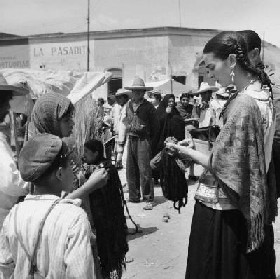A case of malinchismo?

Frida Kahlo came to mind for the harrowing staking at 18 which has to rate as the most known horrific accidents survived whose victim went on to make it stellar for something else. At 6 diagnosed with polio which left her right leg withered; it is also understood she suffered from congenital scoliosis of the spine. Then the dramatic trolley accident:
The bus she was riding in collided with a trolley car; she was found in the wreckage impaled on a metal handrail; the rod had entered her spine in 3 places, boring through her left hip before exiting through the vagina. Her ribs collarbone and hip were fractured, right foot dislocated and crushed, and right leg broken in 11 places. Apart the deep abdominal gash.
Her story hereon's well documented. The confessional artwork - largely self-portraiture, marriage to the celebrated eccentric muralist Diego Rivero, loud liasons, bohemian living and what was considered by decreeing Western circles as captivating good looks. I see a lot of articles around that paint her all kinds of colors, and while there's an explanation for her enforced primitivism, I particularly wonder at writeups that paint her brown, when she was, cascading black hair notwithstanding, quite criollo. What explains this color muddling?
Racism in Latin America
If this is something that hasn't struck you before it's because the Latin American establishment and bizzarely enough the victims themselves are in denial about and accomplices to racism. Mexicos's racial breakup is something like: indios (indigenous) - 10%, mestizos (mix) - 80%, and criollos (white) - 10%. Most mestizos prefer not to trouble themselves with the Indian fraction of their identity - preferring if lucky to pass for white (with the great genetic hybridization among the mestizos, racism is also intra-familial). The criollos are direct descendants of the Spanish and have over the years maintained a certain racial purity, and as it turns out it's the criollos who are disproportinately represented in positions of influence in commerce and government, in fact their representation and control is a majority. The ideal of beauty for many Mexicans is mainstream European; native features are considered feo(ugly):
"Turn on any television program, examine the advertisements in any magazine or newspaper, look at the billboards. You would hardly know you’re in Mexico. Almost all the persons in the ads are lily-white, of pure European extraction. Very occasionally, one might encounter a mestizo. But never a Tzeltal or Tarahumara or Purépecha or Yaqui." http://www.worldpolicy.org/globalrights/mexico/1994-0211-gazette-racism.html
As Jose Agustin says in his article, what makes the situation iniquitous is that unlike in India where it was accepted that the caste system was enshrined in India's belief leads - so in a sense tagged, this racial division is enshrined nowhere in Mexican life; it was just a natural condition, which means if it isn't a problem the law doesn't address it; so no token affirmative action like reservation. Why should the silence of the majority be troubling? Maybe because having chosen to ignore their vital history theyre condemned to repeat it: Aztec emperor Moctezuma himself mistook Cortes for the god Quetzalcoatl before being eviscreated along with his empire. Cultural diveristy was played down and Spanish decreed national langugage (like Hindi here). Which is why the Zappatista rebellion in Chiapas is a necessary and good thing.
The point??

So, hoping not to seem vituperative, have to object to descriptions of Kahlo as the regular brown Mexican about town. Kahlo was by all accounts comfortably (or had well made it to) criolla, her father was Hungarian and mother half-Spanish; even her own stylised later traditional getup and hairfix was a careful construct towards a defined primitive persona - a move husband Rivera strongly advised: he stressed "the Indian aspects of her heritage" http://www.leninimports.com/frida_kahlo_bio.html: as much about ensuring a credibility in art circles as about creating an identity. She goaded the myth along. So lets agree that in the context she was from the start necessarily elevated for a color that empowered and anointed in the context. A kind of pre-destination to pioneer, conquer. To take away nothing at all from her greatness in any circumstances. But if this was going to be the accepted ideal of Mexico, honored within and toasted abroad, what was it saying?
...
On the subject of race/color, rags like TOI and unfortunately even Deccan (for their perpelexing loyalty to contributors primarily the miserable Marianne de Nazareth) show what, not just straining ambivalence but unbridled euphoria at the sighting of preferred but rare racial traits in this city, can descend into. A leap of their inconsequential hearts so absurd not worthy of a replay here.
...
References:
http://www.findarticles.com/p/articles/mi_m0AZV/is_4_41/ai_97724256/pg_2
http://www.globalexchange.org/countries/mexico/racism.html
http://www.worldpolicy.org/globalrights/mexico/1994-0211-gazette-racism.html
http://www.counterpunch.org/russell01252003.html
http://www.nmwa.org/collection/profile.asp?LinkID=471

3 Comments:
I am curious to know why the author feels Marianne de Nazareth is miserable? He he!
Could Finny Forever get in touch with me please at---- solidquick.1234@gmail.com
Finny Forever or whatever your name is. Come out woman and talk about Marianne. She is my abs favourite journalist and unfortunately writes very rarely now as she s out of the country.
If you have any guts, reveal yourself and substantiate your slander.
Post a Comment
<< Home